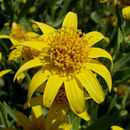Description
provided by eFloras
Plants 30–60(–110) cm. Stems (often relatively numerous, clustered in clonal patches) simple. Leaves 5–7 pairs, mostly cauline (basal leaves usually withered by flowering); sessile or subsessile (proximalmost with connate-sheathing bases); blades lanceolate to lance-elliptic, 5–12(–15) × 1.5–3.5 cm, margins usually entire, rarely denticulate, apices acute to acuminate, faces scabrid-puberulent, sometimes glandular (distal leaves not much reduced). Heads 3–20(–35). Involucres turbinate-campanulate. Phyllaries 11–15(–20), narrow to broadly lanceolate. Ray florets 6–15; corollas yellow. Disc florets 6–11; corollas yellow; anthers yellow. Cypselae brown to black, 3–7 mm, glabrous or sparsely hirsutulous, stipitate-glandular; pappi stramineous to tawny, bristles barbellate to subplumose. 2n = 57, 76.
- license
- cc-by-nc-sa-3.0
- copyright
- Missouri Botanical Garden, 4344 Shaw Boulevard, St. Louis, MO, 63110 USA
Synonym
provided by eFloras
Arnica longifolia subsp. myriadenia (Piper) Maguire; A. myriadenia Piper
- license
- cc-by-nc-sa-3.0
- copyright
- Missouri Botanical Garden, 4344 Shaw Boulevard, St. Louis, MO, 63110 USA
Comprehensive Description
provided by North American Flora
Arnica longifolia D. C. Eaton, in S. Wats. Bot. King's Expl
186. 1871.
Arnica polycephala A. Nels. Bot. Gaz. 30: 202. 1900.
Rootstock much branched, often forming clumps; stems several, 3-8 dm. high, strawcolored, puberulent and glandular-granuliferous; offsets rarely seen in collections, their blades 10-15 cm. long, linear-oblanceolate, acute at the apex, tapering at the base into the petiole; basal leaves withered at the flowering time; stem-leaves several pairs, linear-lanceolate or linear, entire or denticulate, sessile or the lower with a connate sheathing base, 8-15 cm. long, 1-2 cm. wide, more or less puberulent and glandular-granuliferous; heads numerous, in leafy cymes; peduncles 4-10 cm. long; involucre turbinate, about 10 mm. high, 10-15 mm. broad, hirsute, puberulent, and glandular-granuliferous; bracts 16-20, linear-lanceolate, attenuate or acuminate; ray-flowers 10-15, the ligules pale-yellow, 10-12 mm. long, 4 mm. wide, 3-toothed at the apex, the tube strongly pubescent; disk-corollas 6 mm. long, the tube densely villous; achenes 5 mm. long, glandular-granuliferous and sometimes also slightly hirsute; pappusbristles yellowish, 7 mm. long, short-plumose.
Type locality: Clover Mountains. Nevada.
Distribution: Montana to Washington, Colorado, and California.
- bibliographic citation
- Per Axel Rydberg. 1927. (CARDUALES); CARDUACEAE; LIABEAE, NEUROLAENEAE, SENECIONEAE (pars). North American flora. vol 34(4). New York Botanical Garden, New York, NY
Comprehensive Description
provided by North American Flora
Arnica myriadenia Piper, Proc. Biol. Soc. Wash 33: 106. 1920.
Rootstock or caudex much branched; stems several, 3-5 dm. high, densely glandularpuberulent and somewhat hirsutulous above; basal leaves at flowering time none; cauline leaves 4 or 5 pairs, sessile; blades of the lower ones sheathing at the base, oblanceolate, tapering gradually towards the apex, sparingly denticulate or entire, glandular-muricate on both sides, 4—12 cm. long; upper stem-leaves lanceolate, acuminate; heads 3-5; involucre turbinatehemispheric, 2 cm. broad; bracts about 1 1, narrowly lanceolate, acuminate, densely glandulargranuliferous, and slightly hairy; ligules bright-yellow, 1.5 cm. long, 3-toothed at the apex, the corolla-tube and lower portion of the ligule strongly pubescent ; disk-corollas 6 mm. long, the tube villous; achenes 5 mm. long, glandular-granuliferous and sparingly hirsute; pappusbristles yellowish, short-plumose.
Type locality: Mount Rainier National Park. Washington. Distribution: Known only from the type locality.
- bibliographic citation
- Per Axel Rydberg. 1927. (CARDUALES); CARDUACEAE; LIABEAE, NEUROLAENEAE, SENECIONEAE (pars). North American flora. vol 34(4). New York Botanical Garden, New York, NY
Arnica longifolia: Brief Summary
provided by wikipedia EN
Arnica longifolia is a North American species of arnica in the sunflower family, known by the common names seep-spring arnica,: 112 longleaf arnica and spearleaf arnica. This flowering perennial is native to the forests of western Canada (British Columbia + Alberta) and the western United States (Rocky Mountains, Cascades, Coast Ranges, Sierra Nevada and other mountains of California, Oregon, Washington, Idaho, Nevada, Utah, Wyoming, Colorado, and Montana).
Arnica longifolia is a rhizomatous plant forming large bunching patches of groundcover in moist, cool areas. The foliage is rough, mint-green, and sometimes sticky with glandular secretions. The stems are erect and bear daisylike flower heads with deep yellow ray florets and yellow to reddish or orange disc florets. The fruit is a reddish achene with a small pappus.
- license
- cc-by-sa-3.0
- copyright
- Wikipedia authors and editors

